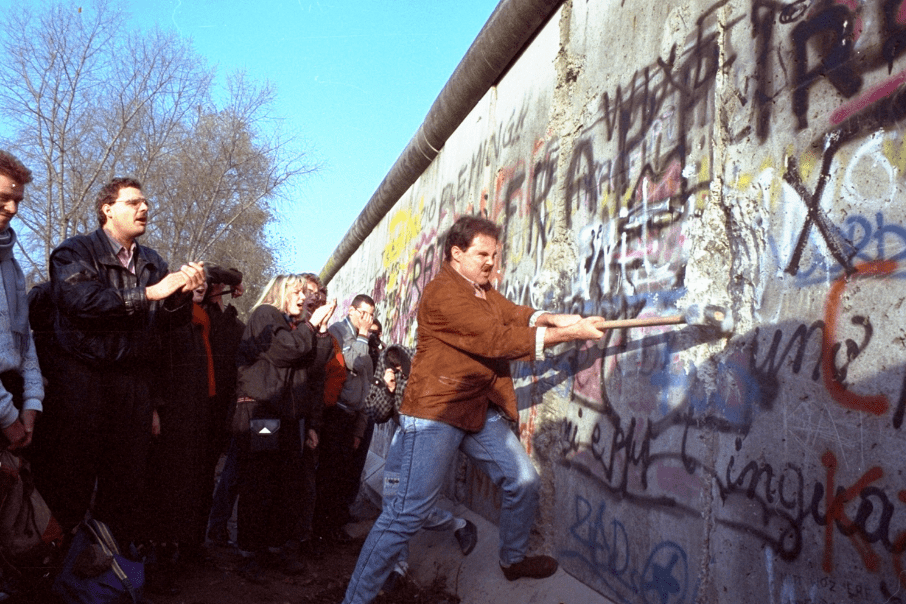In German, the Berlin Wall, or Berliner Mauer, was erected in the dead of night on August 13, 1961, as a physical barrier between West Berlin and East Germany. Its goal was to prevent disgruntled East Germans from emigrating to the West.
President Ronald Reagan delivered a memorable address in front of the Brandenburg Gate in Berlin on June 12, 1987, more than 25 years after the Berlin Wall first split the city’s East and West. He challenged his Soviet counterpart Mikhail Gorbachev, saying, “Mr. Gorbachev, take down this wall.”
On November 9, 1989, the Wall of Berlin fell almost as quickly as it had been built. The German people, not Mr. Gorbachev, ultimately tore down the barrier. The Berlin Wall’s past is one of separation and repression and a desire for freedom — and the events leading up to the wall’s fall are no exception. The Berlin Wall became a symbol of the Cold War and the Iron Curtain between Soviet-led Communism and Western democracy for 28 years. The event was celebrated all around the world when it happened. This certainly was one of the top political events of the 80s.
The Rise of the Berlin Wall
The former Communist occupation zone became the German Democratic Republic on October 7, 1949, while the three Allied zones created the Federal Republic of Germany on May 23, 1949.
West Berlin became an outpost within Communist East Germany since the city of Berlin was entirely under the Soviet zone of occupation. West Germany’s economy expanded fast as a consequence of the assistance offered by its occupying forces. In East Germany, the situation was the polar opposite. Economic recovery was sluggish and stagnated as valuable assets were returned to the Soviet Union. With many East Berliners escaping the situation, the Berlin Wall, a physical barrier between the two sides of Berlin, was erected in August 1961. It left an unsightly scar on the German landscape and served as a symbol of its split.
Attempts to go over, under, or around the wall resulted in the deaths of at least 171 individuals. Over 5,000 East Germans successfully crossed the border between 1961 and 1989, leaping out of windows of buildings near the wall or scrambling over barbed wire. Some even tried to cross in hot air balloons, crashing through in high-speed cars, or crawling through sewers.
What is the size of the Berlin Wall?
The Berlin Wall was 96 miles or 155 kilometers long in all. It not only went through the heart of Berlin, but it also looped around West Berlin, isolating it from the rest of East Germany.
During its 28-year existence, the wall has undergone four significant modifications. It started as a concrete-post barbed-wire fence. It was soon rebuilt with a sturdier, more framed installation just days later, on August 15. This one was built of concrete blocks with barbed wire on top. In 1965, the third iteration of the wall was installed, which consisted of a concrete wall supported by steel girders.
When the Berlin Wall fell, a 300-foot No Man’s Land had been built on the outside and an extra inside wall. Soldiers with dogs patrolled the area, and raking the dirt showed any tracks. Anti-vehicle trenches, electric fences, massive light systems, 302 watchtowers, 20 bunkers, and even minefields were all built by the East Germans. The East German government’s propaganda over the years claimed that the people of East Germany embraced the wall. In actuality, the tyranny they experienced and the possible consequences of speaking up stopped many from doing so.
The Unification of Eastern and Western Germany
In 1989, Mikhail Gorbachev, the General Secretary of the Communist Party of the Soviet Union, was persuaded that the Soviet Union required change. As a prerequisite for his reforms, he required disarmament and a reduction in Cold War conflicts in Europe. Gorbachev was also in favor of easing press censorship and reducing government control over economic concerns. This new openness strategy has already resulted in disputed elections in Poland and changes in Hungary in May 1989. The Soviet Union’s willingness to assist hardline Communist regimes in Eastern Europe was becoming increasingly evident.
“Permanent relocations can be done at all border checkpoints between East Germany and West Germany or West Berlin,” East German government official Günter Schabowski said in an announcement on November 9, 1989.
People were stunned. Is it true that the borders were genuinely open? East Germans approached the border cautiously and discovered that the border guards were allowing individuals to pass.
People from both sides rapidly overran the Berlin Wall. With hammers and chisels, some began chipping away at the Berlin Wall. People hugged, kissed, sang, cheered, and cried along the Berlin Wall.
The Berlin Wall was finally dismantled and dismantled into smaller fragments. The pieces have become collectibles, and they may be found in both private collections and museums. At the spot of Bernauer Strasse, there is currently a Berlin Wall Memorial.
On October 3, 1990, East and West Germany united as a single German state following the fall of the Berlin Wall.

